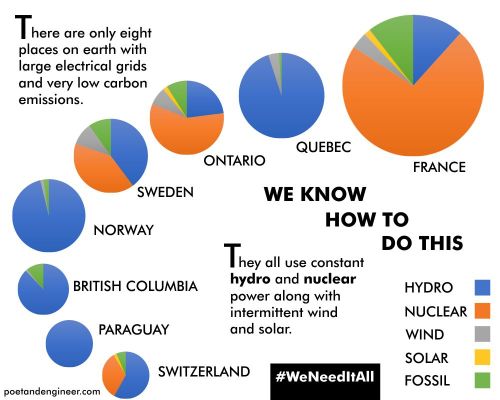With so much media coverage and political debate on the need to reduce our use of fossil fuels, you’d think there must be some very difficult decisions to make, or some very complex new technology required, because for all the talk there doesn’t seem to be much change.
Would it surprise you to learn that there are already eight places in the world with major electricity systems which use almost no fossil fuels?
They have shown us all that it isn’t difficult to power countries using other means. Some of these eight have been like that for decades.

The one characteristic that all these places have in common is their reliance on hydroelectric dams and/or nuclear power, coupled with some wind and solar. That’s because countries need power all day and all night, and hydro and nuclear can deliver that constant supply.
It’s not difficult, and it’s been done before, eight times. To see how your country measures up you can go to the same place I got my information from, the statistics page at the International Energy Agency.
For those who are interested in numbers, I got all the national data from the IEA link above. Canadian province data is from the National Energy Board. In all cases the data is 2016. I defined “large electricity system” as more than 50 TWh per year. The eight examples range from Switzerland (63 TWh) to France (556 TWh). Between the eight, their electricity is 47% hydro, 41% nuclear, 4% wind, 1% solar and 7% fossil fuel.
There are several smaller countries which also have very clean electricity systems, in fact that’s where I started with this little project. I saw a video from Greenpeace claiming seven countries were running on 100% renewables. The problem was that the video showed cartoons of wind turbines and solar cells, but when I looked at the facts all seven used hydro power, and because they are quite small, they are able to power the whole country with a single technology. (The video only shows national flags for the seven – perhaps to make it difficult to look up the data? But I am naturally curious, and I love looking up flags, so I learned that this other group includes: Bhutan, Nepal, Costa Rica, Albania, Iceland, Ethiopia and Lesotho).
The Greenpeace video challenges the rest of the world to copy the example of those seven small countries. I suppose my diagram at the top of the page has the same message. It’s worth adding that in my home province of Ontario, hydro and nuclear power represent the two cheapest sources of electricity, half the price of wind and a fraction of our natural gas or solar power.
We know how to do this.

The chart has a significant error: wind and fossil are switched – fossil is actually the grey color, and wind is green. The chart looked odd so I checked the figures for France.
LikeLike
Hi Steve, I appreciate your taking a look. I want to be accurate. I checked my data and it looks right though. I am using the figures from Canada’s federal National Energy Board. The data is 2016 (I guess I could update for 2017 now they have published it). But BC for instance was 88.5% hydro and 1.5% wind in 2016. For France I use the International Energy Agency data, also 2016.
Which data source are you looking at?
LikeLike
First thing to pop up in Google: Electricity sector in France. Bottom: The Cruas nuclear power plant at night. The electricity sector in France is dominated by nuclear power, which accounted for 72.3% of total production in 2016, while renewables and fossil fuels accounted for 17.8% and 8.6%, respectively.
Electricity sector in France – Wikipedia
https://en.wikipedia.org/wiki/Electricity_sector_in_France
LikeLike
It’s more messed up than that: in Quebec the grey slice actually does represent the wind portion.
LikeLike
I *think* wind is consistently grey… Happy to know if I have made an error, thanks.
LikeLike
And, could we please color green power green, and dirty power grey?
LikeLike
And biomass/geothermal is 6% in BC.
LikeLike
This is a good point. I group all biomass into the “carbon” category with fossil. I should look to see the split between bio and geo (which is genuinely carbon-free)
LikeLike
It seems that in your graphic, wind and fossil are switched. Wind should be green. Appreciate if you can double check it.
LikeLike
Hi Lenka, thanks for looking at the details here – appreciated. I want to be accurate. I checked my data and it looks OK. I am using the Canadian federal National Energy Board 2016 data for Canadian provinces, and the International Energy Agency for data for other countries (also 2016). What data set are you looking at?
LikeLike
What is the fraction limit that you used to consider as “major”?
LikeLike
The 8 places listed have large grids ( more than 50 TWh electricity generated each year), and very low carbin (90% or more from carbon-free sources)
LikeLike
ahh… ok…
that explains why Brazil is out… =P
LikeLike
Exactly. Total hydro power in Brazil is HUGE, bigger than any other country but still only 75% of total and rest comes from coal and gas
LikeLike
not exact figures, but ok…
hydro is 66%, actually, but carbon-free sums up to 83%…
but I got your point… =)
LikeLike
I’m a huge proponent of nuclear. It should be pointed out that hydro isn’t feasible in all countries all over the world though. There’s massive environmental and ecosystem impacts by building large dams. Look at the Three Gorges in China. Also, wind/solar aren’t necessarily “green” in the long run. The minerals and material needed to build these still have to be mined, and their lifespans are much shorter than nuke. Not the mention the large physical area that wind/solar need to occupy, compared to the relatively small amount of power they produce. That said, nuke is the way to go, generally.
LikeLike